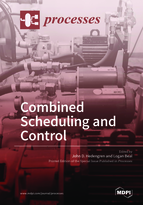Combined Scheduling and Control
A special issue of Processes (ISSN 2227-9717). This special issue belongs to the section "Process Control and Monitoring".
Deadline for manuscript submissions: closed (31 December 2017) | Viewed by 47116
Special Issue Editors
Interests: advanced process control; APMonitor software; drilling automation; nonlinear optimization; state estimation; unmanned aerial vehicles
Special Issues, Collections and Topics in MDPI journals
Special Issue Information
Dear Colleagues,
Advanced optimization algorithms and increased computational resources are opening new possibilities to integrate control and scheduling. Some of the most popular advanced control methods today were conceptualized decades ago. Over a time span of 30 years, computers have increased in speed by about 17,000 times and algorithms such as integer programming have a speedup of approximately 150,000 times on some benchmark problems. With the combined hardware and software improvements, benchmark problems can now be solved 2.5 billion times faster; i.e., applications that formerly required 120 years to solve are now completed in 5 seconds. New computing architectures and algorithms advance the frontier of solving larger scale and more complex integrated problems. Recent work demonstrates economic and operational incentives for merging scheduling and control.
There are many remaining areas for development. Improvement is needed with optimization algorithms that converge within a controller cycle time, improve scale-up with many discrete variables (especially in MINLP), exploit unique problem structures, and utilize strengths of emerging computing architectures. An example of a recent development is in scale-bridging models that serve as surrogates for the scheduler to encapsulate a simplified description of the control dynamics. Nonlinear relationships are needed where feedback linearization or linear dynamic models are not sufficient to capture the control dynamics. Further development towards unification of scheduling and control particularly needs industrial application with guidance on benefits and further development opportunities.
Suggested contributions to this Special Issue include approaches to formulating combined objective functions, multi-scale approaches to integration, mixed discrete and continuous formulations, estimation of uncertain control and scheduling states, mixed integer and nonlinear programming advances, benchmark development, comparison of centralized and decentralized methods, and software that facilitates creation of new applications and long-term sustainment of benefits. Contributions should acknowledge strengths, weaknesses and potential further advancements of their work, along with a demonstration of improvement over current industrial best-practice.
Assoc. Prof. Dr. John D. Hedengren
Dr. Logan Beal
Guest Editors
Manuscript Submission Information
Manuscripts should be submitted online at www.mdpi.com by registering and logging in to this website. Once you are registered, click here to go to the submission form. Manuscripts can be submitted until the deadline. All submissions that pass pre-check are peer-reviewed. Accepted papers will be published continuously in the journal (as soon as accepted) and will be listed together on the special issue website. Research articles, review articles as well as short communications are invited. For planned papers, a title and short abstract (about 100 words) can be sent to the Editorial Office for announcement on this website.
Submitted manuscripts should not have been published previously, nor be under consideration for publication elsewhere (except conference proceedings papers). All manuscripts are thoroughly refereed through a single-blind peer-review process. A guide for authors and other relevant information for submission of manuscripts is available on the Instructions for Authors page. Processes is an international peer-reviewed open access monthly journal published by MDPI.
Please visit the Instructions for Authors page before submitting a manuscript. The Article Processing Charge (APC) for publication in this open access journal is 2400 CHF (Swiss Francs). Submitted papers should be well formatted and use good English. Authors may use MDPI's English editing service prior to publication or during author revisions.
Keywords
- scheduling
- control
- optimization
- scale-bridging
- mixed integer
- nonlinear programming
- estimation







